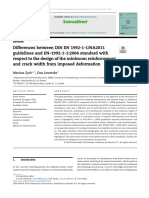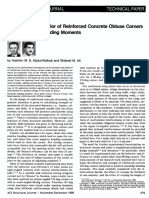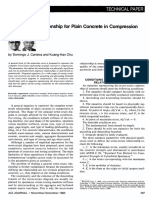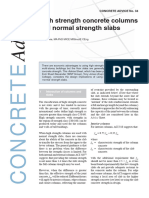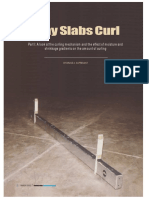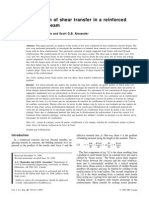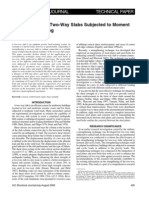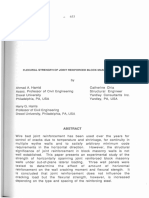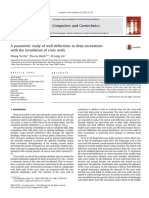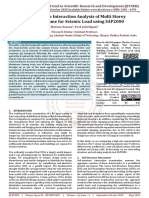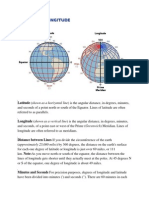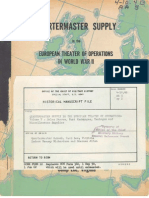98s11 PDF
98s11 PDF
Uploaded by
paulkohanCopyright:
Available Formats
98s11 PDF
98s11 PDF
Uploaded by
paulkohanOriginal Title
Copyright
Available Formats
Share this document
Did you find this document useful?
Is this content inappropriate?
Copyright:
Available Formats
98s11 PDF
98s11 PDF
Uploaded by
paulkohanCopyright:
Available Formats
ACI STRUCTURAL JOURNAL TECHNICAL PAPER
Title no. 98-S11
Reinforcement Detailing in Concrete Frame Corners
by Morgan Johansson
Results of an experimental study and a literature survey of the
reinforcement detailing in concrete frame corners subjected to
closing or opening moment are presented in this study. A total of
11 full-scale specimens, eight for closing moment and three for
opening moment, were tested to evaluate whether a new reinforce-
ment detailing using reinforcement loops lap spliced within the
corner is appropriate to use in Swedish civil defense shelters. In
combination with nonlinear finite element analyses (not presented
herein), it was found that the new detailing, even though resulting
in a higher risk of side concrete spalling within the corner, was suf-
ficient to be used. Further, it is shown that the use of inclined bars, Fig. 1—Schematic figures of details previously described in
commonly accepted in opening frame corners, may not be as effec- Swedish Shelter Regulations for: (a) closing moment; (b)
tive as previously believed. opening moment; and (c) new proposal examined.
Keywords: moment; reinforced concrete; spalling.
INTRODUCTION
From a safety point of view, it is important that a reinforced
concrete structure, apart from necessary load capacity, is also
able to show ductile behavior so that a local failure does not
lead to total collapse of the structure. A structure’s ability to ex-
hibit such behavior is highly dependent on the reinforcement
detail of the joint connections between its adjoining members.
Ideally, the joint should resist a moment at least as large as the
estimated failure moment of the structural members connected
to it and ensure ductile behavior in the ultimate limit state. The
reinforcement detailing of frame corners previously described Fig. 2—Simple sketch of principal forces in corner sub-
in the Swedish Shelter Regulations (1994) shown in Fig. 1(a) jected to: (a) positive (opening) moment; and (b) negative
and (b) were regarded as difficult to carry out correctly at the (closing) moment.
construction site. Thus, even though they fulfilled the structural
requirements for a joint connection mentioned previously,
and Bennison (1972), and Nilsson (1973) carried out extensive
there was a need for a simpler detailing. Therefore, a detail in
test series where many different reinforcement details were ex-
which all reinforcement bars are lap spliced within the corner
region (Fig.1(c)) was proposed and evaluated in this study. amined. Other valuable contributions to the knowledge of open-
Concrete frame corners can be separated into two principal ing corners have been made by: Swann (1969), Noor (1977),
types: those that are subjected to a positive moment (opening Stroband and Kolpa (1981), Jackson (1995), and Abdul-Wahab
of the corner) and those subjected to a negative moment and Al-Roubai (1998). Of these, Swann, Mayfield et al. (1971),
(closing of the corner). By the use of a simple strut-and-tie and Stroband and Kolpa (1983) also studied the behavior of
model, it can be seen that opening of the corner tries to split closing frame corners, while other researchers in this field in-
the corner in two by pushing off the outside portion (Fig. 2). clude Balint and Taylor (1972), Plos (1994), and Lundgren
This is the opposite of what happens when closing the cor- (1999).
ner; the tensile and compressive forces then interact in a way The aim of this study was to investigate whether the proposed
that instead confines the concrete between them. According- reinforcement detail (Detail c in Fig. 1) is appropriate to use in-
ly, the two cases also present quite different difficulties in stead of the conventional ones (Details a and b in Fig. 1). To do
their respective reinforcement detailing. Generally speaking, this, a combination of full-scale tests, comparison to previous
it can be said that an opening moment is characterized by the research, and nonlinear finite element analyses was carried out.
concrete tensile failure, while a closing moment depends This paper, though, is limited to the first two parts; for informa-
more on the compressive strength of the concrete. Conse- tion about the finite element analyses, see Johansson (1996),
quently, in theoretical and experimental studies, it has also
Johansson and Karlsson (1997), and Johansson (2000a).
been concluded that the reinforcement detailing of frame
corners is more sensitive in the former case than the latter
(Mayfield et al. 1971; Nilsson and Losberg 1976). There- ACI Structural Journal, V. 98, No. 1, January-February 2001.
MS No. 00-068 received March 24, 2000, and reviewed under Institute publication
fore, the main effort of experimental studies has also been policies. Copyright © 2001, American Concrete Institute. All rights reserved, includ-
concentrated on frame corners subjected to opening mo- ing the making of copies unless permission is obtained from the copyright propri-
etors. Pertinent discussion will be published in the November-December 2001 ACI
ments. Specifically, Mayfield et al. (1971), Mayfield, Kong, Structural Journal if received by August 1, 2001.
ACI Structural Journal/January-February 2001 105
Morgan Johansson received his PhD from the Division of Concrete Structures at
Chalmers University of Technology, Sweden. His research interests include reinforce-
ment detailing in frame corners, transient loading of concrete structures, and concrete
behavior at high strain rates.
EXPERIMENTS
To examine the effectiveness of the new detail when sub-
jected to an opening or a closing moment, three test series
were carried out. In the first two series, each consisting of four
specimens, the effect of a closing moment was examined. Two
specimens were reinforced with the conventional detail and
six with the new proposal. Opening of frame corners was
studied in the third test series, with one specimen using the
conventional detail and two using the new proposal (Table
1). This paper, though, emphasizes the second and third test
series; results obtained in the first test series were previously
reported in Plos (1994), but are briefly included herein be-
cause it was part of the same project. Thus, unless otherwise
stated, the descriptions of the closing moment tests refer to
the specimens in the second test series. More information
about the two latter test series can be found in Johansson
(1996) and Johansson and Karlsson (1997), respectively.
Fig. 3—Dimensions and test setup of: (a) first and second test
Some brief test results regarding the closing corners have pre-
viously been presented and compared with nonlinear finite el- series (closing moment); and (b) third test series (opening
moment.)
ement analyses in Johansson (2000a).
The dimensions and test setup of the frame corners used
in the three test series are shown in Fig. 3. The amount of strength of the concrete. This statement is especially true for
reinforcement (hot-rolled, deformed bars) used in the first frame corners subjected to opening moment, where the con-
two test series corresponded approximately to the maximum crete behavior in tension may have a very large influence on
and minimum amount of reinforcement allowed in the the overall response, but also in closing moments when there
Swedish Shelter Regulations. The reinforcement ratio used in
is risk of spalling of the concrete side cover or crushing of the
the third test series was based on the high reinforcement ratio in
the previous test series as further described in the following sec- compressive zone. A variable that takes these factors into con-
tions. In the first two test series, the influence of a construction sideration, however, is the mechanical reinforcement ratio
joint was also examined. According to the Swedish Shelter
Regulations, the reinforcement amount in such a joint should be f sy A s f sy
increased by at least 25% compared with that in the adjoining ω s = ρ ----- = ------------ (1)
fc bdf c
members. In the first test series, however, the specimens
with new detail (RV2 and RV4) had an unequal amount of
reinforcement in the sections adjacent to the frame corner where A s is the amount of reinforcement; b is the specimen
(Table 1). In the second test series, though, the adjoining width; d is the effective height; fsy is the reinforcement yield
sections of the frame corner were designed to be of equal strength; and fc is the compressive strength of the concrete.
strength. To obtain a construction joint, one adjoining mem- Accordingly, this term is also used in the present paper,
ber was cast first, and 4 days later, the second adjoining
while the reinforcement ratio ρ is only shown for reference.
member and corner joint were cast. The specimens were
made in pairs; the two specimens that would be directly com- The critical sections used in the frame corners when deter-
pared with each other were cast with concrete from the same mining the expected load capacity were defined as shown in
batch. The specimens in the third test series did not have a Fig. 4(a). Thus, the critical crack in the closing frame corners
construction joint and were all cast at the same time. The dis- was assumed to appear just outside the corner; the critical
tance from the center of the outermost bar to the free concrete crack in the opening frame corners was assumed to form at the
sides was 40 mm in the closing frame corners. In the opening inside of the corner and then propagate along the reinforce-
frame corners, this distance was doubled to 80 mm in an at- ment loops. When determining the amount of reinforce-
tempt to avoid spalling failure of the side concrete cover. The
ment loops in Specimen RV11, the idea was that the
concrete covers on the tensile and compressive side of the
specimens were 1.5φ in all specimens, where φ is the nominal amount of reinforcement crossing the initial crack at the in-
bar diameter used. The reinforcement bars were in all speci- side of the corner should be approximately the same as
mens positioned in one layer only. The strength of the con- that used in the specimen reinforced with inclined bars
crete used was determined by tests on water-cured cylinders (for example, Specimen RV9). This can be achieved as
(φ150 x 300 mm) at the day of testing according to Swedish shown in Fig. 4(b). Hence, the necessary amount of rein-
standard, BST Byggstandardiseringen (1991). forcement in the loops can be determined as
It is common to discuss the reinforcement ratio ρ when de-
termining the allowable amount of reinforcement in a frame
corner. This measure, however, is inadequate because it does 1
A s ∗ = A s + -------A s, i (2)
not take into account the reinforcement yield strength or the 2
106 ACI Structural Journal/January-February 2001
Table 1—Reinforcement amount and details in tested frame corners
Reinforcement
Adjoining
Type of moment Detail* Test specimen members Corner fsy, MPa fc , MPa ρ, % ωs
a RV1 6 φ 16 8 φ 16 473 29.7 1.00 0.159
c RV2 6 φ 16 6 φ 16 † 473 29.7 0.75 0.119
a RV3 4 φ 10 5 φ 10 504 28.7 0.23 0.041
c RV4 4 φ 10 4 φ 10 ‡ 504 28.7 0.19 0.033
c RV5 5 φ 16 7 φ 16 567 30.6 0.88 0.162
c RV6 5 φ 16 7 φ 16 567 30.6 0.88 0.162
c RV7 3 φ 10 4 φ 10 573 33.8 0.19 0.032
c RV8 3 φ 10 4 φ 10 573 33.8 0.19 0.032
b RV9 5 φ 16 5 φ 16 § 570 32.2 0.63 || 0.110||
c RV10 5 φ 16 5 φ 16 570 32.2 0.63 0.110
c RV11 5 φ 16 7 φ 16 570 32.2 0.88 0.155
*
Notation refers to that used in Fig. 1.
†
Unequal amount in adjacent sections; 8 φ 16 crossed construction joint.
‡
Unequal amount in adjacent sections; 5 φ 10 crossed construction joint.
§ Also 3 φ 16 inclined bars.
||
ρ = 0.89 and ωs = 0.158 if inclined bars are taken into account, as shown in Eq. (2).
Fig. 4—(a) Definition of critical section in closing and opening corner; and (b) determi-
nation of equivalent amount of reinforcement loops when inclined bars are replaced.
where As* is the loop reinforcement area in Detail c and As first test series, two primary cracks were observed close to the
and A s,i are the loop reinforcement area and area of the in- corner in all the specimens, one in each section adjacent to the
clined bars, respectively, in Detail b. corner. As mentioned previously, however, the frame corners
reinforced with the new detail in the first test series (Specimens
RESULTS RV2 and RV4) had an unequal amount of reinforcement in the
Closing moment sections adjacent to the frame corner. This caused the deforma-
The load on the frame corners in the first and second test tions to concentrate in just one plastic hinge in these specimens,
series was controlled manually so that it could be adjusted to and was also the reason for the lower load capacity obtained
the response of the specimen. Thus, it was also possible to for Specimens RV2 and RV4 compared with that of Speci-
register the postpeak behavior in a relatively controlled man- mens RV1 and RV3, respectively. The other six specimens,
ner. The load was initially applied in load increments of 5 or 10
though, developed plastic hinges on either side of the corner.
kN for the specimens with low and high amounts of reinforce-
ment, respectively. At each increment, the load was held con- For Specimens RV5 and RV6, very few cracks were ob-
stant while the propagation of cracks was marked. To make it served outside the immediate vicinity of the frame corner. The
easier to follow the behavior of the frame corners near the behavior of the two specimens was similar, and the maximum
maximum load, the load increments were halved when a non- load was determined for both of them by spalling of the con-
linear response was observed. The total time of testing for crete side cover in the frame corner. Even so, strain gages
each specimen was approximately 2 h. glued on the two reinforcement loops next to the center bar
The load-displacement relations for the closing frame cor- registered a strain of approximately 5‰, thus indicating that
ners are shown in Fig. 5. The efficiency of the tests, that is, the the reinforcement yielded at maximum load. Before the spal-
ratio between the moment obtained in each test Mut and the es- ling occurred, the largest cracks were observed in the section
timated theoretical moment capacity Muc, are presented in Ta- between the corner and the upper adjoining member. In the
ble 2. During the initial loading of the frame corners in the two tests of the specimens with a low reinforcement ratio, cracks
ACI Structural Journal/January-February 2001 107
Table 2—Summary of test results in three test series
Estimated
Mu t
Test Load in test F, Moment in test capacity M uc, --------- ,%
Type of moment Detail* specimen ωs kN M ut , kNm kNm M uc
a RV1 0.159 175 210 193 109
c RV2 0.119 133 161 145 128
a RV3 0.041 44 53 50 107
c RV4 0.033 37 45 38 116
c RV5 0.162 147 178 203 87
c RV6 0.162 150 180 203 89
c RV7 0.032 42 50 45 112
c RV8 0.032 42 50 45 112
† ‡
b RV9 0.110 109 133 136/192 98/70‡
c RV10 0.110 87 107 136 79
c RV11 0.155 115 141 187 75
*
Notation refers to that used in Fig. 1.
ω s = 0.158 if inclined bars are taken into account.
†
‡
Inclined bars not accounted for/inclined bars accounted for.
(a) (b)
Fig. 5—Load-displacement relations for frame corners subjected to closing moment: (a)
high reinforcement ratio; and (b) low reinforcement ratio. Specimens RV1 to RV4 tested by
Plos (1994).
were formed with a spacing of approximately 0.20 m be- hydraulic jack, while Specimens RV6 to RV8 were deformed
tween them in both adjoining members. The cracks that led until rupture of two (RV6) or three (RV7 and RV8) reinforce-
to failure for Specimen RV7 appeared in the upper adjoining ment bars was obtained. The crack patterns obtained in the
member close to the corner; for Specimen RV8, the decisive specimens of the second test series were very similar when us-
crack appeared along the construction joint. For both speci- ing a high or low reinforcement ratio, respectively. Therefore,
mens, the first crack was observed in the construction joint photos only of Specimens RV6 and RV7 are shown (Fig. 6).
at a load level lower than expected. Apart from the lower
crack load, however, the construction joint did not appear to Opening moment
have any effect on the overall behavior—a statement also The testing of the opening frame corners in the third test se-
confirmed in the nonlinear finite element analyses carried ries was controlled by means of displacement control, as
out (Johansson [2000a]). shown in Fig. 3(b). Initially the load was applied with a dis-
The maximum displacements in Specimens RV1 to RV3 placement rate of 0.15 mm/min. To limit the total time needed
were governed by limitations in the test rig; Specimen RV4, for one test, however, the speed was doubled to 0.3 mm/min
though, was loaded until failure when two reinforcement bars approximately10 min after reaching the maximum load. Due
were torn off. Specimen RV5 still showed ductile behavior to an error in the initial loading of RV9, the displacement rate
when the test had to be stopped because of the obliquity of the of this specimen was approximately 3 mm/min until reaching
108 ACI Structural Journal/January-February 2001
Fig. 7—Load-displacement relations of frame corners sub-
(a) jected to opening moment.
within the corner started again. The cracks then deviated in the
direction of the adjoining members (3) and eventually, just
prior to the maximum load, the cracks closed around the rein-
forcement loops (4), hence limiting the corner capacity when
the concrete part outside the reinforcement spalled off. The
crack patterns for the three specimens at the end of the test
are shown in Fig. 8. Furthermore, longitudinal cracks were
observed on the tensile side approximately 80 to 100 mm
from the free concrete sides (that is, approximately at the lo-
cation of the outer reinforcement loops) in both Specimens
RV9 and RV11 shortly before the maximum loads were
reached. In Specimen RV10, such cracks were observed af-
ter maximum load was reached. The mean crack spacing of
the bending cracks observed outside the corner region was
approximately 0.21 m.
(b) DISCUSSION OF TEST RESULTS
Estimation of theoretical load capacity
Fig. 6—Crack patterns at end of test in: (a) Specimen RV6; The theoretical strength of each specimen was determined
and (b) Specimen RV7. by using a concrete stress block as described in, for example,
Eurocode 2 (1991). The effect of normal force due to the ex-
a load of 33 kN, at which time it was unloaded. It was then ternal load and the reinforcement on the compressive side
loaded again, this time using the correct displacement rate. were accounted for. Furthermore, due to the test setup used
Even though it is unlikely that this had any significant effect for the closing frame corners, the dead weight had a relative-
on the specimen’s maximum load capacity, the initial crack ly large influence on the theoretical load capacity in these
pattern might have been somewhat influenced. The load-dis- specimens, especially for the frame corners with low rein-
placement relations for the opening frame corners are com- forcement ratio. Therefore, the dead weight was considered
pared in Fig. 7; for a summary of the obtained load capacities for these specimens and, thus, the estimated moment capacity
and efficiencies of the details, refer to Table 2. The small ir- Muc given in Table 2 is not the moment capacity in the critical
regularities in the curves are due to stops made during loading section, but the product of the estimated maximum point load
to mark the crack propagation in the specimen. The loading and its lever arm of 1.202 m to this section. In the specimens
was stopped when reaching a postpeak load of approximately subjected to opening moment, the dead weight had only a
80% of the maximum load (RV9 and RV10) or when the small effect and was therefore neglected. The same method
large deformations of the frame corners caused problems in was also used in the re-evaluation made in the following sec-
the test setup (RV11). tions of test results reported in the literature.
Figure 8(a) shows a schematic crack propagation similar
to that obtained in all tests. The first crack appeared at the in- Closing moment
side of the corner (1), and then followed the reinforcement Due to uneven capacities in the adjoining member, it is not
loops until it approached the compressive reinforcement (2). possible to make a direct comparison of the specimens in the
At this stage the load was still quite low, only approximately first test series. The efficiencies, however, were all greater
30 to 40 kN, and the forming of new cracks in the corner than 100% and the ductility was similar, thus indicating that
came to a standstill while the existing ones inside the corner the examined details are comparable. The unusually high ef-
increased in size. It was not until a load of approximately 80% ficiency obtained in Specimen RV2 was due to substantial
of the final maximum load that any serious crack propagation hardening in the reinforcement; as can be seen in Fig. 5;
ACI Structural Journal/January-February 2001 109
(a) (c)
(b) (d)
Fig. 8—Crack patterns in frame corner subjected to opening moment: (a) schematic sketch of crack propagation; (b) Specimen
RV9; (c) Specimen RV10; and (d) Specimen RV11. Dark rectangle inside corner marks position of concrete strain gage.
however, yielding of the reinforcement first occurred at a example, the loss of concrete cover may influence the bars
load of approximately 121 kN, which corresponds well to the further from the free side too and cause them to lose their an-
estimated load capacity of 120 kN. Because of the spalling chorage capacity as well, something that probably also hap-
of the concrete side cover in Specimens RV5 and RV6 in the pened herein. The fact that two reinforcement bars in RV6
second test series, a somewhat lower maximum load capaci- were torn off before the end of the tests, however, shows that
ty than expected was obtained. Also, the plateau in the load- the innermost bars were still fully active. Hence, contrary to
displacement relation, observed for RV1 and RV2, did not what is said in Stroband and Kolpa (1983), the spalling did
appear. The differences between the estimated and observed not give rise to a sudden failure. The reason for this was that
maximum load capacities for the specimens with low rein- even though the contribution of the outer bars in Specimens
forcement ratios were similar, though, and the large plateau RV5 and RV6, due to loss of anchorage, largely disappeared
in the load-displacement relation was observed in all tests. close to the maximum load, the inner bars were still able to
Based on experience gained in tests on simply supported balance a large part of the load. The specimen width and
beams of identical concrete cross sections and spliced with number of reinforcement bars used by Stroband and Kolpa in
the same type and amount of reinforcement loops as used their tests were 70 mm and 2φ6, respectively. Thus, when the
herein, according to Grassl (1999), it can be assumed that the reinforcement loops started to fail in anchorage due to the
efficiency of the outermost bars due to the spalling of the spalling, there were no extra bars to assist in balancing the
concrete cover probably was only approximately 50% when internal section force.
the maximum load was reached. On this assumption, the es- Accordingly, if a large percentage of the total reinforce-
timated load capacity obtained would be 144 kN, a value that ment amount is affected by spalling, as may be the case in
corresponds quite well with the loads of 147 and 150 kN beam-column joints, there is a risk of brittle behavior. From
reached in the tests of the specimens that spalled (that is, the tests, it can be concluded that there is higher risk of spal-
RV5 and RV6). Because of the spalling, the strain in the inner ling of the side concrete cover when using the new proposal
reinforcement bars increased more rapidly near the maximum (that is, Detail c) than is the case when using the conventional
load in an attempt to compensate for the loss of the outermost detail shown in Fig. 1(a), an observation that is in agreement
bars. Eventually, though, depending on the bar spacing, for with those made by Stroband and Kolpa. If, however, the cor-
110 ACI Structural Journal/January-February 2001
ner is laterally restrained, or if only a small percentage of the Furthermore, the postpeak behavior in Specimens RV9 and
total number of reinforcement bars are affected, this type of RV10 was more or less the same; a somewhat more ductile be-
failure has a very limited, if any, effect on the total load-car- havior was obtained in RV11. Based on the amount of rein-
rying capacity or ductility of the corner. Thus, the risk of a forcement loops used in each specimen, this indicates that the
spalling failure in a civil defence shelter is small and, even if response in this stage to a large degree depends on the
such a failure were initiated, its effect would be quite negligi- amount of reinforcement loops, while the presence of in-
ble due to the large width used in a wall-slab connection. clined bars seems to have a quite negligible effect in this
Hence, the test results together with these observations sup- stage.
port the idea that it would be appropriate to use the new detail
in corners subjected to closing moment. Special care still has COMPARISON WITH OTHER RESEARCH
to be taken, however, when using reinforcement loops in As mentioned in the introduction, various researchers have
beam-column connections where the effect of spalling can been working with the behavior of frame corners subjected to
have a large influence. closing or opening moment, or both, and several details have
been tested and evaluated. An attempt is made herein to sum-
Opening moment marize the test results known by the author using the details
According to previous research, the details used in Speci- shown in Fig. 1 and details similar to those as shown in Johans-
mens RV10 and RV11 (that is, reinforcement loops without son (2000b). Different combinations, using various amounts
inclined bars) are inferior to those used in RV9 (inclined bars and types of secondary reinforcement, are not considered. Due
included). This, however, was not clearly the case in the tests to this, the work by Luo et al. (1994) was not included. Further-
carried out. Even though the inclined bars supplied in RV9 re- more, the tests reported by Östlund (1963) were not taken into
sulted in an increased load capacity compared with that of account because no information about the reinforcing steel
RV10, the structural response was quite similar for all three strength was available.
specimens. It is especially interesting to note that RV9 and The load-displacement relations after maximum load are
RV11 showed almost exactly the same stiffness until maxi- rarely shown in the literature. This is due to the use of pure
mum capacity was reached, a value that was also more or less load-controlled testing by which it is not possible to register
the same in the two tests. According to Nilsson, diagonal the postpeak behavior. Accordingly, this makes it hard to know
cracks within the loops or along the inclined bars are the cause anything about the postpeak ductility obtained when using dif-
of failure in the details tested. In an attempt to register the de- ferent details. Many results are instead reported only as the ra-
velopment of the cracks within the reinforcement loops, strain tio of the maximum moment obtained in tests and the
gages were glued on the concrete (Fig. 8). Such cracks did not theoretical estimated ultimate moment. Such results reported
form, however, as described by Nilsson; in fact, it was not un- by various researchers on frame corners subjected to closing
til after maximum load that the strain gages even indicated and opening moment, respectively, are illustrated in Fig. 9 and
tensile stresses in this region (Johansson and Karlsson 1997). 10; a thorough summary of the results can be found in Johans-
Instead, maximum load was governed by spalling of the con- son (2000b). Due to limited space, the sources of the test re-
crete outside the reinforcement loops. When this occurred, the sults in these figures are only identified by the use of the
anchorage decreased and the reinforcement loops started to author’s name first mentioned in the reference list. Most of
slide around the concrete sprint in the corner. Hence, the failure these reports originally refer to the concrete compressive
obtained in these tests can probably best be characterized as an strength as the cube strength. Because the compressive
anchorage failure, an observation also made by Jackson strength used for design in both Eurocode 2, and the Swedish
(1995) in his tests. The photos in Fig. 8 also show that the final regulations BBK 94 (1994), is related to the cylinder strength
crack patterns were more or less the same, independent of and a recalculation was done in those cases. The relation used
whether inclined bars were used or not. was taken from Swedish Standard SS 13 72 07, BST Bygg-
The reinforcement loops in both RV9 and RV11 yielded in standardiseringen (1991), which states that the relation be-
the direct vicinity of the initial crack at the inside of the cor- tween the compressive strength for normal-strength concrete
ner; the strains measured as high as 12%. Nevertheless, the obtained from water-cured cylinders (φ150 x 300 mm) and
load level at this stage was still considerably smaller than the cubes (side 150 mm) cured dry can be approximated as
theoretical one. The strain gages used to register the strain in
the reinforcement, though, were glued on the two bars next f c,c u b e
to the center bar and are thus not necessarily representative f c,c y l = --------------- (3)
for the bars next to the free concrete side. Hence, based on 1.35
the observations made by Grassl discussed in the previous
section, this strongly indicates that the load capacity of the where fc,cyl and fc,cube are cylinder and cubic compressive
opening frame corners was affected by spalling of the side strengths of the concrete, respectively. Even though the curing
concrete cover. This statement is also strengthened by the conditions of the cubes and cylinders used to determine the
appearance of the longitudinal cracks observed close to the concrete strength differed a great deal between different re-
free concrete sides in both specimens before reaching maxi- searchers, only this one expression was used. The difference
mum load. Accordingly, it is the author’s belief that if spal- obtained in the results shown in the following sections are
ling of the side concrete cover had been prevented, a higher rather negligible regardless of whether another expression is
load capacity would also have been obtained in the tests. used. Due to this recalculation of the concrete compressive
Whether the efficiency would have reached 100%, though, is strength and the fact that all results were not evaluated in an
unclear but not probable because the forming of the critical identical manner by the original authors (for example, some
crack around the reinforcement loops (Crack 4 in Fig. 8(a)) at considered the compressive reinforcement, some did not),
a later stage would still have affected the anchorage capacity the theoretical strength Muc of each specimen was redeter-
and thus decreased the force taken by the reinforcement loops. mined. As mentioned in the Discussion section, this was
ACI Structural Journal/January-February 2001 111
(a) (b)
Fig. 9—Efficiency of frame corners subjected to closing moment when reinforcement detailing var-
ies. Dashed line marks maximum mechanical reinforcement ratio allowed in Swedish Shelter Regu-
lations.
(a) (b)
Fig. 10—Efficiency of frame corners subjected to opening moment when different details are used.
Dashed line marks maximum mechanical reinforcement ratio allowed in Swedish Shelter Regula-
tions.
done by using the method given in Eurocode 2, that is, ne- approximately fc = 27 MPa for the lowest concrete quality al-
glecting the influence of the dead weight but taking into ac- lowed (K30), and the mean reinforcement yield strength of
count the effect of any compressive reinforcement and normal approximately fsy = 550 MPa, it is possible to determine an
force from the external load. All results were evaluated in the upper limit to ωs = 0.224 by using Eq. (1). This upper limit
same way, and consequently, the efficiencies shown herein of ω s is also marked in Fig. 9 and 10.
may differ from those reported by the original authors. From Fig. 9, it can be seen that most tests on closing frame
When comparing the efficiencies of the different details, no corners with a mechanical reinforcement ratio lower than 0.224
consideration has been given to those that had a considerably obtained an efficiency of at least 100% or more, independently
higher mechanical reinforcement ratio ωs than that allowed in of what detail was used. Of the results below full efficiency, it
the design of civil defence shelters in Sweden. The reinforce- can be mentioned that at least three were due to spalling failure
ment ratio permitted in the present Swedish Shelter Regula- (Stroband and Kolpa, and the author of this study) and one was
tions (1998) is 1.1%. Together with the mean strength of because the maximum moment was limited due to shear failure
112 ACI Structural Journal/January-February 2001
(a) (b)
Fig. 11—Comparison of efficiencies for Details b and c in tests on opening moment when: (a)
inclined bars are not taken into account; and (b) inclined bars are taken into account.
Fig. 12—Schematic figures of test setups used by different researchers in tests on opening
moment.
(Lundgren). The reason for the low efficiencies obtained in the maximum moment obtained in these tests dependent on its
tests by Balint and Taylor, though, are not known to the au- capacity, these results still indicate that the efficiencies of
thor. Nevertheless, this comparison supports the statement both details are quite similar.
made by Mayfield et al. (1971) that the reinforcement corner In most tests carried out on frame corners subjected to opening
detail is not very important in closing frame corners. As can moment, the test setup was arranged so that at least one of the ad-
be seen in Fig. 10, however, this is not the case with opening joining members had a constant moment acting on it (Fig. 12).
frame corners. Due to this, further discussion focuses on the This procedure is not on the safe side, though, because such a
opening of frame corners. member may then fail in any section independent of the dis-
When comparing the efficiencies of Details b and c in tance from the corner (this is, for instance, what happened in
opening frame corners, shown in Fig. 10, it may first appear many of Nilsson’s tests). Accordingly, if the external mo-
that the former is superior to the latter. A comment about ment decreases with increasing distance to the corner, the
these results should first be made. When Nilsson and other possibility for a critical crack to develop outside the corner
researchers determined the efficiency of Detail b, they did also decreases (also refer to Johansson [2000b] for further
not include the contribution to the moment capacity from the treatment about this subject). In addition, the author is not
inclined bars; neither did they take this extra reinforcement aware of any tests but those presented in this paper where the
into account when determining the reinforcement ratio of the reinforcement loops were lap spliced to straight bars just out-
detail. If this is done as described in Eq. (2), the result will side the corner region. Still, such a procedure is frequently
also be quite different (Fig. 11). Accordingly, even though it used and, for instance, is even given as an example in ACI
is important to be aware that the specimens with inclined 315 (1999) of how such a detail should be carried out. Pro-
bars often failed in an adjoining member, hence making the vided that such a splice is carried out correctly, it usually
ACI Structural Journal/January-February 2001 113
produces a stronger section due to the higher amount of rein- CONCLUSIONS
forcement, thus effectively hindering the development of a A combination of full-scale tests and a literature survey of
plastic hinge in the adjoining member close to the corner. concrete frame corners subjected to closing or opening mo-
The test setup used for the tests presented in this paper ment was carried out to evaluate the usage of a new reinforce-
was arranged so that the moment varied along the adjoining ment proposal, using reinforcement loops spliced within the
members. Consequently, a more critical load case was ob- corner, in Swedish civil defense shelters.
tained. Furthermore, as shown in Fig. 1, the reinforcement Although there is a greater risk of spalling of the side con-
loops were spliced to straight bars in the adjoining members crete cover, it was concluded that it is suitable to replace the
conventional detailing previously used in closing frame cor-
just outside the corner, thus strengthening those parts close
ners with the new one. Special care still has to be taken,
to the corner. The result from the test was also that the usage
however, when using this kind of reinforcement detail in
of inclined bars in Specimen RV9 did not prevent the criti- beam-column connections where the effect of spalling can
cal cracks from forming within the corner, something that to have large influences on the final capacity.
a large degree contradicts previous observations reported in It was found that the commonly accepted reinforcement
the literature. Hence, the combination of varying moment detail in opening corners, using inclined bars at the inside of
and extra amount of reinforcement was sufficient to prevent the corner, may not be as effective as previously believed; its
the development of a critical crack in the adjoining mem- efficiency largely depends on the applied moment distribu-
bers before the corner failed. Of the results summarized tion and the detail of the reinforcement just outside the cor-
herein, only Kordina and Fuchs (1970) and Jackson (1995) ner area. A similar effect can instead be obtained by the
used a test setup in which the applied moment varied in both presence of extra reinforcement loops, thus making the de-
members adjoining the corner. Based on this, it is interesting tailing easier to carry out. It was also found that even though
to note that the tests of Kordina and Fuchs did not reach full full efficiency of such a corner detail may not be achieved,
efficiency. Unfortunately, Jackson did not carry out any ductile behavior may very well still be obtained. While the
tests with inclined bars. When increasing the number of re- test series is quite limited, it still indicates that the postpeak
inforcement loops in Specimen RV10 (and thus obtaining response of opening frame corners depends to a large degree
Specimen RV11) so that the effective amount of reinforce- on the amount of reinforcement loops, whereas the influence
ment area that crossed the critical crack at the inside of the cor- of any inclined bars seems to be small.
ner was similar to that used in Specimen RV9, the structural The work presented has, in combination with nonlinear fi-
behavior and final load capacity also became quite similar. nite element analyses, resulted in a change of the previous
Shelter Regulations so that the detail evaluated herein now is
Accordingly, it can be concluded that the usage of inclined
also valid for use in the design of civil defense shelters in
bars is not more effective in strengthening the corner region Sweden.
than is the use of extra reinforcement loops; the test results pre-
sented herein even indicate the opposite. Instead, it is the lower
ACKNOWLEDGMENTS
amount of reinforcement in the adjoining member compared The research presented in this paper was financed by the Swedish Rescue
with that in the corner that has caused the failure to occur out- Services Agency. The author would like to thank Kent Gylltoft, head of the
side the corner in most such tests reported in the literature. Division of Concrete Structures, for his support and advice. Special thanks are
due to Björn Ekengren at the Swedish Rescue Services Agency and Mario
Hence, the reliability of the inclined bars depends on the ex-
Plos for their much appreciated and encouraging support in the project. The
ternal moment distribution and whether the reinforcement author would also like to express his gratitude to Mathias Johansson and
loops are lap spliced to straight bars just outside the corner. Stefan Karlsson for their valuable contributions in the testing and evaluation
When using only reinforcement loops it is unlikely that the fi- of the opening frame corners. Thanks also to the staff of the Structural En-
gineering Laboratory, for their invaluable assistance in the experimental as-
nal failure will occur outside the corner. This is because the pect of this work.
loops increase the load capacity in the adjoining member just
as much as in the corner. Thus, because the external applied NOTATION
moment probably reaches its maximum within the corner and As = reinforcement area
the theoretical moment capacity is the same in both cases, it is A s* = effective reinforcement area when inclined bars are considered
inevitable that the critical section also will be positioned at the A s,i = reinforcement area of inclined bars
b = width
inside of the corner. Even so, as has been shown in the tests
C = compressive force
presented herein, quite a ductile behavior might very well still d = effective height
be the case. Consequently, the inclined bars could equally well F = load
instead be replaced by extra reinforcement loops. If a response Fs = force in reinforcement loops
similar to that obtained when using inclined bars is wanted, F s* = effective force when inclined bars are considered
Eq. (1) can be used to determine the necessary amount of extra F s,i = force in inclined bars
fc = compressive strength of concrete
reinforcement loops in the connection. The amount of inclined
fc,cube = compressive cube strength of concrete
bars previously prescribed in the Swedish Shelter Regulations fc,cyl = compressive cylinder strength of concrete
was based on the recommendations given in Nilsson (1973), fsy = reinforcement yield strength
and thus required this amount to be at least half that of the rein- M uc = estimated moment capacity
forcement loops used. Therefore, by using Eq. (1) it can be con- M ut = maximum moment obtained in test
cluded that, if Detail c is to be used the total amount of R = resultant force
T = tensile force
reinforcement loops shall be approximately 1.35As, where As is
δ = displacement
the amount of reinforcement needed if the efficiency of the de- ρ = reinforcement ratio
tail had been 100%. This value is also what is prescribed in the φ = diameter
present Shelter Regulations (1998). ωs = mechanical reinforcement ratio
114 ACI Structural Journal/January-February 2001
REFERENCES Luo, Y. H.; Durrani, A. J.; Bai, S.; and Yuan, J., 1994, “Study of Reinforcing
Abdul-Wahab, H. M. S., and Al-Roubai, A. A. M., 1998, “Strength and Detail of Tension Bars in Frame Corner Connections,” ACI Structural Journal,
Behavior of Steel Fiber-Reinforced Concrete Corners under Opening V. 91, No. 4, July-Aug., pp. 486-496.
Bending Moment,” Magazine of Concrete Research , V. 50, No. 4, Dec.,
Mayfield, B.; Kong, F. K.; Bennison, A.; and Davies, J. C. D. T., 1971,
pp. 305-318.
“Corner Joint Details in Structural Lightweight Concrete,” ACI JOURNAL,
Abdul-Wahab, H. M. S., and Salman, S. A. R., 1999, “Effect of Corner
Angle on Efficiency of Reinforced Concrete Joints under Opening Bending Proceedings V. 68, No. 5, May, pp. 366-372.
Moment,” ACI Structural Journal, V. 96, No. 1, Jan.-Feb., pp. 115-121. Mayfield, B.; Kong, F. K.; and Bennison, A., 1972, “Strength and Stiff-
ACI Committee 315, 1999, “Details and Detailing of Concrete Reinforce- ness of Lightweight Concrete Corners,” ACI JOURNAL, Proceedings V. 69,
ment (ACI 315-92),” American Concrete Institute, Farmington Hills, Mich. No. 7, July, pp. 420-427.
Balint, P. S., and Taylor, H. P. J., 1972, “Reinforcement Detailing of Nilsson, I. H. E., 1973, “Reinforced Concrete Corners and Joints Sub-
Frame Corner Joints with Particular Reference to Opening Corners,” Tech-
jected to Bending Moment,” National Swedish Institute for Building
nical Report 42.462, Cement and Concrete Association, London, 16 pp.
Research, Document D7:1973, Stockholm, Sweden.
BBK 94, 1994, “Boverkets Handbok för Betongkonstruktioner BBK 94,
Band 1, Konstruktion (Boverket’s Handbook for Concrete Structures, BBK Nilsson, I. H. E., and Losberg, A., 1976, “Reinforced Concrete Corners
94, V. 1, Design),” Boverket, Byggavdelningen, Karlskrona, Sweden, 185 pp. and Joints Subjected to Bending Moment,” ASCE Journal of the Structural
(in Swedish) Division, V. 102, No. 6, June, pp. 1229-1254.
BST Byggstandardiseringen, 1991, “Betongprovning med Svensk Standard, Noor, F. A., 1977, “Ultimate Strength and Cracking of Wall Corners,”
BST handbok 12, utgåva6 (Concrete Testing According to Swedish Standard,
Concrete , Cement and Concrete Association, London, July, pp. 31-35.
BST Handbook 12, Sixth Edition),” SIS—standardiserings-kommisionen i
Sverige och Svensk Byggtjänst, Stockholm, Sweden, 285 pp. (in Swedish) Östlund, L., 1963, “Inverkan av bockningsradier och täckande betong-
Eurocode 2, 1991, “Design of Concrete Structures Part 1: General Rules skikt hos kamstål på spjälkningsrisken för armerade betongkonstruktioner
and Rules for Buildings,” European Committee for Standardisation, 253 pp. (The Influence of Bending Radius and Concrete Cover for Deformed Bars
Grassl, P., 1999, “Splicing of Reinforcement Loops in Beams: Experi- on the Risk of Splitting Failure in Reinforced Concrete Structures),” The
ments and Non-Linear Finite Element Analyses,” Division of Concrete Royal Institute of Technology, Stockholm, Sweden. (in Swedish)
Structures, Chalmers University of Technology, Master’s thesis 99:4, Göte- Plos, M., 1994, “Splicing of Reinforcement in Frame Corners—Experi-
borg, Sweden.
Jackson, N., 1995, “Design of Reinforced Concrete Opening Corners,” mental Studies,” Nordic Concrete Research, Publication No. 14, The Nordic
The Structural Engineer, V. 73, No. 13, July, pp. 209-213. Concrete Federation, Norsk Betongforening, Oslo, Norway, pp. 103-121.
Johansson, M., 1996, “New Reinforcement Detailing in Concrete Frame Shelter Regulations, 1994, “Shelter Regulations, SR English Edition,”
Corners of Civil Defense Shelters: Non-Linear Finite Element Analyses Swedish Rescue Services Agency, Publication B54-168/94, Karlstad, Swe-
and Experiments,” Division of Concrete Structures, Chalmers University of den, 1994, 94 pp.
Technology, Licentiate thesis 96:1, Göteborg, Sweden. Shelter Regulations, 1998, “Skyddsrumsregler SR—Produktion och vid-
Johansson M., 2000a, “Non-Linear Finite Element Analyses of Concrete
makthållande (Shelter Regulations—Production and Maintenance),” Swed-
Frame Corners,” ASCE Journal of Structural Engineering, V. 126, No. 2,
ish Rescue Services Agency, Publication B54-141/98, Karlstad, Sweden,
Feb., pp. 190-199.
Johansson M., 2000b, “Structural Behavior in Concrete Frame Corners 167 pp. (in Swedish)
of Civil Defense Shelters: Non-Linear Finite Element Analyses and Exper- Skettrup, E.; Strabo, J; Andersen, N. H.; and Brondum-Nielsen T., 1984,
iments,” Division of Concrete Structures, Chalmers University of Technol- “Concrete Frame Corners,” ACI JOURNAL, Proceedings V. 81, No. 6, Nov.-
ogy, PhD thesis 00:2, Göteborg, Sweden. Dec., pp. 587-593.
Johansson, J. P. M., and Karlsson, S., 1997, “Nytt armeringsutförande i
Stroband, J., and Kolpa, J. J., 1983, “The Behavior of Reinforced Concrete
betongramhörn utsatta för positivt moment (New Reinforcement Detailing
in Concrete Frame Corners Subjected to Positive Moment),” Division of Column-to-Beam Joints, Part 1: Corners Subjected to Negative Moments,”
Concrete Structures, Chalmers University of Technology, Master’s thesis Stevin Laboratory, Delft University of Technology, Report 5-83-9, Delft, The
97:5, Göteborg, Sweden. (in Swedish) Netherlands, 105 pp.
Kordina, K., and Fuchs, G., 1970, “Untersuchungen zur Anwendung von Stroband, J., and Kolpa, J. J., 1981, “The Behavior of Reinforced Concrete
hakenförmigen Übergreifungsstößen in Rahmenecken (Examination of the Column-to-Beam Joints, Part 2: Corners Subjected to Positive Moments,”
Use of Reinforcement Loops in Frame Corners,” Institut für Baustoffkunde Stevin Laboratory, Delft University of Technology, Report 5-81-5, Delft, The
und Stahlbetonbau, Der Technischen Universität Braunschweig, Braunsch-
Netherlands, 103 pp.
weig, Germany. (in German)
Lundgren, K., 1999, “Static Tests of Frame Corners Subjected to Closing Swann, R. A., 1969, “Flexural Strength of Corners of Reinforced Con-
Moments,” Division of Concrete Structures, Chalmers University of Tech- crete Portal Frames,” Technical Report TRA 434, Cement and Concrete
nology, Report 99:2, Göteborg, Sweden. Association, London.
ACI Structural Journal/January-February 2001 115
You might also like
- Diferenças Entre DIN e EC2 2019Document12 pagesDiferenças Entre DIN e EC2 2019lab100% (1)
- Adjusting EntriesDocument16 pagesAdjusting EntriesClarice Guintibano50% (6)
- KKM Chechlist For Operating SystemDocument11 pagesKKM Chechlist For Operating SystemNoordin Abdul MajidNo ratings yet
- Strength and Behavior of Reinforced Concrete Obtuse Corners Under Opening Bending MomentsDocument6 pagesStrength and Behavior of Reinforced Concrete Obtuse Corners Under Opening Bending MomentspaulkohanNo ratings yet
- State - of - The - Art - Review - Piles - in - Clay - (Revised - 17th December)Document56 pagesState - of - The - Art - Review - Piles - in - Clay - (Revised - 17th December)ALANG CANDRA MARSUDIANTONo ratings yet
- Effect of Corner Angle On Efficiency of Reinforced Concrete Joints Under Opening Bending MomentDocument7 pagesEffect of Corner Angle On Efficiency of Reinforced Concrete Joints Under Opening Bending MomentpaulkohanNo ratings yet
- Ongetal 2004MCRDocument10 pagesOngetal 2004MCRamanh7618No ratings yet
- Shukla Sivakugan Das IJGE Jan 2009-89-108Document21 pagesShukla Sivakugan Das IJGE Jan 2009-89-108Enrique BarragánNo ratings yet
- Behavior of Thin Lightly Reinforced Flat Slabs Under Concentric LoadingDocument16 pagesBehavior of Thin Lightly Reinforced Flat Slabs Under Concentric LoadingJoão Paulo de AlmeidaNo ratings yet
- Takeuti 2007Document12 pagesTakeuti 2007amanh7618No ratings yet
- Analysis - ofBareFrame and Infilled Frame PDFDocument6 pagesAnalysis - ofBareFrame and Infilled Frame PDFagustinussetNo ratings yet
- Unit 14 Design of Slender ColumnsDocument32 pagesUnit 14 Design of Slender ColumnsSh Jvon Sh JvonNo ratings yet
- Concrete Defects in Bored Piles As A Result of Insufficient Applications of Chemical AdmixturesDocument13 pagesConcrete Defects in Bored Piles As A Result of Insufficient Applications of Chemical AdmixturesNorendro KangjamNo ratings yet
- Under Reamed Piles ComparisonDocument15 pagesUnder Reamed Piles ComparisonMaheswara VarmaNo ratings yet
- (2001 REGAN E SAMADIAN) Shear Reinforcement Against Punching in RC Flat SlabsDocument8 pages(2001 REGAN E SAMADIAN) Shear Reinforcement Against Punching in RC Flat SlabsMarcus FreitasNo ratings yet
- Design of ACI-type Punching Shear Reinforcement To Eurocode 2Document15 pagesDesign of ACI-type Punching Shear Reinforcement To Eurocode 2ephremNo ratings yet
- Out of Plane Bending of Concrete Block WallsDocument13 pagesOut of Plane Bending of Concrete Block Wallsmanish_shashikant100% (1)
- Design of Bored Piles in Residual SoilsDocument10 pagesDesign of Bored Piles in Residual SoilsMaanvir SatyaNo ratings yet
- 612 - ACI STRUCTURAL JOURNAL by Wiryanto Dewobroto PDFDocument168 pages612 - ACI STRUCTURAL JOURNAL by Wiryanto Dewobroto PDFchaval01No ratings yet
- SEISMIC DESIGN - Chapter 6 PDFDocument27 pagesSEISMIC DESIGN - Chapter 6 PDFSyed Arsalan AliNo ratings yet
- References 2 PDFDocument3 pagesReferences 2 PDFHanafiahHamzahNo ratings yet
- 82 72Document8 pages82 72Chetan B ArkasaliNo ratings yet
- Effects of Opening On The Behavior of Reinforced Concrete Beam I011275261Document10 pagesEffects of Opening On The Behavior of Reinforced Concrete Beam I01127526101010No ratings yet
- Lateral Earth Pressure in Expansive Clay SoilsDocument14 pagesLateral Earth Pressure in Expansive Clay SoilsSamad Arabi100% (1)
- Gravity Load Collapse of Reinforced Concrete Frames: Kenneth J. ElwoodDocument77 pagesGravity Load Collapse of Reinforced Concrete Frames: Kenneth J. ElwoodRachid BENTAFATNo ratings yet
- Paulay Thesis Vol1Document249 pagesPaulay Thesis Vol1alex_axinteNo ratings yet
- 34 - High Strength Concrete ColumnsDocument3 pages34 - High Strength Concrete ColumnsIan FloodNo ratings yet
- Affecting Aspects On The Behaviour of Frame Joints: HBRC JournalDocument16 pagesAffecting Aspects On The Behaviour of Frame Joints: HBRC JournalVennela VasupilliNo ratings yet
- The Behaviour of Piles Driven in Clay, Clerk and MayerhofDocument23 pagesThe Behaviour of Piles Driven in Clay, Clerk and MayerhofRakesh7770No ratings yet
- 104-s49 Strength, Stiffness, and Cyclic Deformation CapacityDocument11 pages104-s49 Strength, Stiffness, and Cyclic Deformation CapacityAmr KemalNo ratings yet
- Why Slabs Curl - Part1Document6 pagesWhy Slabs Curl - Part1Tim LinNo ratings yet
- Poulos-1968-The Behaviour of Axially Loaded End-Bearing PilesDocument16 pagesPoulos-1968-The Behaviour of Axially Loaded End-Bearing PilesZhixiongNo ratings yet
- Creep Model For Reinforced Concrete Columns: Aci Structural Journal Technical PaperDocument5 pagesCreep Model For Reinforced Concrete Columns: Aci Structural Journal Technical PaperpicottNo ratings yet
- Fourteenth Buchanan Lecture PDFDocument82 pagesFourteenth Buchanan Lecture PDFAnonymous D5s00DdUNo ratings yet
- Mechanism of Shear TransferDocument8 pagesMechanism of Shear TransferSana'a AamirNo ratings yet
- Chapter 11 of Rock Mass PropertiesDocument43 pagesChapter 11 of Rock Mass PropertiesJosé Luis Illanes100% (1)
- Ice ProgressiveDocument11 pagesIce ProgressiveCorona DrawingNo ratings yet
- CVR Paper On Infill WallsDocument8 pagesCVR Paper On Infill WallsAnandNo ratings yet
- Spread Footing FlexibilityDocument11 pagesSpread Footing FlexibilitypciemakNo ratings yet
- Strengthening of Two-Way Slabs Subjected To Moment and Cyclic LoadingDocument10 pagesStrengthening of Two-Way Slabs Subjected To Moment and Cyclic LoadingMarcel SteoleaNo ratings yet
- Commentary and Recommendations On FEMA 350: Structural Engineers Association of California Seismology CommitteeDocument51 pagesCommentary and Recommendations On FEMA 350: Structural Engineers Association of California Seismology CommitteeDavid Alvarez MirandaNo ratings yet
- Mete SozenDocument13 pagesMete SozenAnastasiadis AnthimosNo ratings yet
- Deep Beam On Elastic FoundationsDocument14 pagesDeep Beam On Elastic FoundationscustomerxNo ratings yet
- Flexural Strength of Joint Reinforced Block Masonry WallsDocument12 pagesFlexural Strength of Joint Reinforced Block Masonry Wallsneve08No ratings yet
- Confined Masonry Construction: Submitted by Alphy Anto Semester 5 Class No: 9 REG NO: 18010375Document17 pagesConfined Masonry Construction: Submitted by Alphy Anto Semester 5 Class No: 9 REG NO: 18010375Riswan Bin HassanNo ratings yet
- 1 s2.0 S1687404814000996 Main PDFDocument16 pages1 s2.0 S1687404814000996 Main PDFgeorgeispasoiuNo ratings yet
- The Effects of Patch Loads On Thin-Walled Steel Silos: M. Gillie, J.M. RotterDocument18 pagesThe Effects of Patch Loads On Thin-Walled Steel Silos: M. Gillie, J.M. RotterAnonymous wWOWz9UnWNo ratings yet
- 426 Scott MenegonDocument10 pages426 Scott MenegonKvrd PrasadNo ratings yet
- Shear Strength of Reinforced Concrete Deep BeamsDocument4 pagesShear Strength of Reinforced Concrete Deep Beamsnevinkoshy100% (1)
- Column Stiffener DetailingDocument31 pagesColumn Stiffener DetailingChristian Santamaria100% (1)
- Bond Under Cyclic LoadDocument5 pagesBond Under Cyclic Loadjeff100% (1)
- Chapter9-Masonry Walls Under Lateral LoadsDocument37 pagesChapter9-Masonry Walls Under Lateral Loadsreadcc.nepalNo ratings yet
- A Parametric Study of Wall Deflections in Deep Excavations With The Installation of Cross Walls PDFDocument11 pagesA Parametric Study of Wall Deflections in Deep Excavations With The Installation of Cross Walls PDFAhmed ArafaNo ratings yet
- (2005) Flexural Behavior of Confined High-Strength Concrete ColumnsDocument8 pages(2005) Flexural Behavior of Confined High-Strength Concrete ColumnsMohammad AshrafyNo ratings yet
- Soil Structure Interaction Analysis of Multi Storey Building Frame For Seismic Load Using SAP2000Document6 pagesSoil Structure Interaction Analysis of Multi Storey Building Frame For Seismic Load Using SAP2000Editor IJTSRDNo ratings yet
- Tests of Reinforced Concrete Continuous Deep Beams: Aci Structural Journal Technical PaperDocument9 pagesTests of Reinforced Concrete Continuous Deep Beams: Aci Structural Journal Technical PaperpicottNo ratings yet
- Slim Concrete Columns EC Vs BS - NHBCDocument25 pagesSlim Concrete Columns EC Vs BS - NHBCalberto5791No ratings yet
- Basic ConceptsDocument22 pagesBasic ConceptsTan Yi LiangNo ratings yet
- Waffle DesignDocument8 pagesWaffle Designmy09No ratings yet
- A Catalogue of Details on Pre-Contract Schedules: Surgical Eye Centre of Excellence - KathFrom EverandA Catalogue of Details on Pre-Contract Schedules: Surgical Eye Centre of Excellence - KathNo ratings yet
- JCSR Krawinkler Mohasseb 1987Document18 pagesJCSR Krawinkler Mohasseb 1987faisaladeNo ratings yet
- Low Cyclic Tests On Headed Stud Connectors in Hybrid Shear Wall SystemsDocument8 pagesLow Cyclic Tests On Headed Stud Connectors in Hybrid Shear Wall SystemsSanNo ratings yet
- DMAM Report 2023 Kahramanmaras-Pazarcik and Elbistan Earthquakes Report Final ENGDocument92 pagesDMAM Report 2023 Kahramanmaras-Pazarcik and Elbistan Earthquakes Report Final ENGpaulkohanNo ratings yet
- 2014 - Dutton2014Document13 pages2014 - Dutton2014paulkohanNo ratings yet
- Engineering Structures: Neil A. Hoult, W. Andy Take, Chris Lee, Michael DuttonDocument9 pagesEngineering Structures: Neil A. Hoult, W. Andy Take, Chris Lee, Michael DuttonpaulkohanNo ratings yet
- 2017 - FayyadDocument19 pages2017 - FayyadpaulkohanNo ratings yet
- Sezen 2012Document10 pagesSezen 2012paulkohanNo ratings yet
- Design of Anchor Reinforcement in Concrete Pedestals: AbtractDocument12 pagesDesign of Anchor Reinforcement in Concrete Pedestals: AbtractpaulkohanNo ratings yet
- Field Performance of An FRP Slab Bridge: Sreenivas AlampalliDocument9 pagesField Performance of An FRP Slab Bridge: Sreenivas AlampallipaulkohanNo ratings yet
- Cyclic Response of Exterior Beam-Column Joints With Different Anchorage MethodsDocument11 pagesCyclic Response of Exterior Beam-Column Joints With Different Anchorage MethodspaulkohanNo ratings yet
- Cost Optimum Design of Reinforced Concrete Simply Supported One-Way SlabsDocument9 pagesCost Optimum Design of Reinforced Concrete Simply Supported One-Way SlabspaulkohanNo ratings yet
- The Influence of Configuration On To The Seismic Resistance of A BuildingDocument8 pagesThe Influence of Configuration On To The Seismic Resistance of A BuildingpaulkohanNo ratings yet
- Seismic Behavior of Nonseismically Detailed Interior Beam-Wide Column Joints-Part I: Experimental Results and Observed BehaviorDocument12 pagesSeismic Behavior of Nonseismically Detailed Interior Beam-Wide Column Joints-Part I: Experimental Results and Observed BehaviorpaulkohanNo ratings yet
- 2013 - Chile PDFDocument11 pages2013 - Chile PDFpaulkohanNo ratings yet
- Story Damage Identification of Irregular Buildings Based On Earthquake RecordsDocument23 pagesStory Damage Identification of Irregular Buildings Based On Earthquake RecordspaulkohanNo ratings yet
- Behavior and Design of Corner Joints Under Opening Bending MomentDocument39 pagesBehavior and Design of Corner Joints Under Opening Bending MomentpaulkohanNo ratings yet
- Numerical Modelling of Cracks in Façades: Extended Abstract Tiago Manuel Ribeiro EstevesDocument15 pagesNumerical Modelling of Cracks in Façades: Extended Abstract Tiago Manuel Ribeiro EstevespaulkohanNo ratings yet
- Concrete Frame Corners: Aci Journal Technical PaperDocument7 pagesConcrete Frame Corners: Aci Journal Technical PaperpaulkohanNo ratings yet
- 1 s2.0 S014102961300059X MainDocument11 pages1 s2.0 S014102961300059X MainpaulkohanNo ratings yet
- LatitudeDocument3 pagesLatitudeshivanadhunichaitanyNo ratings yet
- BSS Nr. 2 (16), 2022Document97 pagesBSS Nr. 2 (16), 2022Sergiu CorneaNo ratings yet
- CHM 580 Exp 1 & 7Document19 pagesCHM 580 Exp 1 & 7Nabilah60% (5)
- Through Lntroduction of Efficient The and EtrikesDocument1 pageThrough Lntroduction of Efficient The and EtrikesRaff LimNo ratings yet
- NSCC Financial DisclosureDocument2 pagesNSCC Financial DisclosureThe Chronicle HeraldNo ratings yet
- Mark Meltons Geomorphology and Geography S Quantitative RevolutionDocument16 pagesMark Meltons Geomorphology and Geography S Quantitative RevolutionrelebohilemochesaneNo ratings yet
- Papers TarnavaDocument182 pagesPapers TarnavagusaNo ratings yet
- Business Proposal Letter To ClientDocument3 pagesBusiness Proposal Letter To ClientharshitNo ratings yet
- 2009 UPLB Annual ReportDocument32 pages2009 UPLB Annual ReportUPLB Office of the Vice Chancellor for Research and ExtensionNo ratings yet
- School Readiness ChecklistDocument1 pageSchool Readiness ChecklistDiane Bantegui-AquinoNo ratings yet
- Growth Strategy Ansoff MatrixDocument4 pagesGrowth Strategy Ansoff MatrixAndrea Demos StylesNo ratings yet
- ToeflDocument23 pagesToeflStephani100% (1)
- CFT Pricelist 2012-2013 1.0Document60 pagesCFT Pricelist 2012-2013 1.0nohead1986No ratings yet
- Peta Persebaran Asf Di Indonesia: 1. Medan 2. Lampung 3. Pontianak 4. Jawa 5. Bali 6. NTT 7. Manado 8. PapuaDocument3 pagesPeta Persebaran Asf Di Indonesia: 1. Medan 2. Lampung 3. Pontianak 4. Jawa 5. Bali 6. NTT 7. Manado 8. PapuaCt ZahraNo ratings yet
- WWII Army Gear & UniformsDocument144 pagesWWII Army Gear & UniformsCAP History Library100% (18)
- Consolidation Test - (Oedometer Test)Document8 pagesConsolidation Test - (Oedometer Test)saleem razaNo ratings yet
- MSS - CIVE2016 Structural Design 1Document8 pagesMSS - CIVE2016 Structural Design 1YashArnatNo ratings yet
- MY Structural Strengthening OVERVIEW 1511Document52 pagesMY Structural Strengthening OVERVIEW 1511Tan Peng LeakNo ratings yet
- Strategic Human Resource Management Strategic Human Resource ManagementDocument11 pagesStrategic Human Resource Management Strategic Human Resource ManagementendaleNo ratings yet
- WM Process CycleDocument39 pagesWM Process Cycleamit chinageNo ratings yet
- Q1-2024 Initiative PlaningDocument10 pagesQ1-2024 Initiative PlaningnageswaraorayalaNo ratings yet
- An Incumbent's Guide To Digital Disruption - McKinsey & CompanyDocument12 pagesAn Incumbent's Guide To Digital Disruption - McKinsey & CompanyRoberto Carlos SandovalNo ratings yet
- QuestionnaireDocument5 pagesQuestionnaireAlex OzfordNo ratings yet
- 7-4 and 7-5 Elastic Collisions: KE KEDocument1 page7-4 and 7-5 Elastic Collisions: KE KEdaminNo ratings yet
- Artapp Group1Document3 pagesArtapp Group1marjannah.mdNo ratings yet
- Virtualization Guide - SUSE Linux Enterprise Server 12 SP2Document366 pagesVirtualization Guide - SUSE Linux Enterprise Server 12 SP2juniorexNo ratings yet
- Siam Report 39 FinalDocument17 pagesSiam Report 39 Finalsiambangladesh2020No ratings yet
